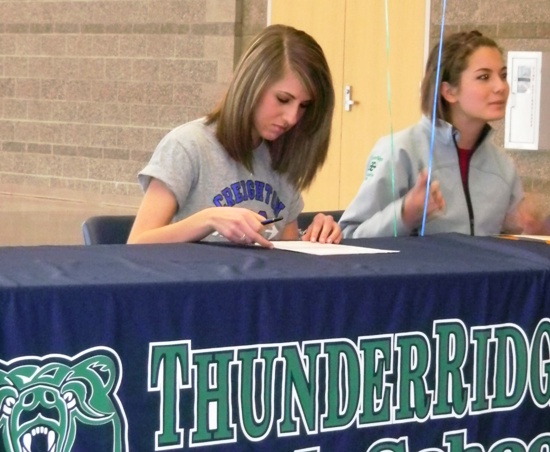With his first season as Creighton’s head cross country coach under his belt, and right before his teams participate in this week’s Mizzou Relays, White & Blue Review caught up with Chas Davis to dissect the 2009 XC season and learn more about the current and future state of the Bluejays’ harriers.
White & Blue Review: When we last saw your men’s and women’s cross country teams, they both finished their seasons at the NCAA Midwest Regional races in Springfield, Missouri. How much of a break did your runners take before getting back to their training plans?
Chas Davis: Two weeks. We gave everyone two weeks to get running off the brain and to do nothing related to running. After that, we start a very gradual, easy mileage build up with a long-term plan in mind.
WBR: Can you tell our readers the basics about the Bluejays’ off-season track events? What types of distances and races will the Jays enter?
CD: Although we are technically in our NCAA defined “off-season,” we no longer take the winter and spring off philosophically. We are in track season for all intents and purposes, and we will take this season no differently than cross country in tone or approach. This is crucial to long-term development on a Division I level.
We’ll race anything from 800 meters to 10,000 meters, but the training will be geared primarily toward the 3,000-5,000 meters races. If the timing is right (which it probably won’t be this track season), a 10,000 meter race is always a possibility. The occasional 800 or 1500/mile race will serve as development in off-distance races and for those runners on our squad that may be more inclined toward the middle distances. But our team will train with the longer distances in mind since we are strictly a distance squad. We actually participated in meets in February and March, and our team competed well.
WBR: Can you recap the races?
CD: I was very pleased with our opening meet of the season on February 19 in Lincoln. We had several people with personal records and breakout performances that we didn’t see coming this early. We’d have expected them come outdoor season, but for a meet in meet February, without any track work under us in practice, our performances were very encouraging.
We saw a different Izzy Squires in the 3000m than we saw all of cross country season with a strongly paced effort and new personal record. She fought to maintain position and was running even splits throughout most of her race, something we hadn’t put any work into yet.
Zach Fuller raced for the first time since last April and walked away with a monster personal record in the 3000m. This as he is coming off of some pretty conservative training after an injury-riddled prior year. In fact, he found himself just about keeping pace with our top man from cross country season, Steve VanGampleare, who brought a strong performance to the track himself.
Freshman Tom Shimp was very close to his mile personal best from high school, an event we hadn’t put any direct preparation into. For him to be racing very close to where he was at his peak in high school is a great sign for things to come during outdoor season.
Seniors Celeste Lorenzo and Molly Jergenson and sophomore Elizabeth Timberlake all demonstrated in the mile that they are entering track season well prepared and fit. Chris Boitano demonstrated the same in the 3000m as well as first time miler Joe Hamel, a recent addition to the squad this winter.
Two weeks later we saw a different race dynamic at the Iowa State Last Chance Qualifier in Ames. Because of the nature of the meet, the competition was either going to be very challenging, or very sparse. But we needed a race effort and another test at this point in the season, so we used friends of mine, ex-standout harriers at Gonzaga, to help pace our runners through their races. It worked perfectly for Celeste Lorenzo, who posted a personal record by 17 seconds from her first 3000m of the season on February 6. After her “rabbit” stepped off, she had to fight by herself to maintain the pace that had been set and executed it beautifully.
Colin McDonald and Joe Hamel did the same thing in their 3000m soon afterward. For these kids to have to run the second half of their races without the help of a large pack of other runners racing at a similar pace was very impressive. We are asking them to go to the absolute edge of their pain tolerance, to pack their body full of searing lactic acid, deprive their senses of oxygen, and do it all without someone to chase at the end of a race…often the only justification to push your body to that point.
I paced our 5000m runners and we saw performances very close to what their peak performances would have been in prior cross country and track seasons. We had a few of our runners that really jumped out and took risks early with their paces and it proved to take its toll, but I was thrilled they gave it a shot and they’ll be more prepared for that sort of effort when they have more help. It all suggests that with another month under our squad, we will be demonstrating that Creighton is serious about competing on the track.
This week’s Mizzou Relays will be many of our runner’s first 5000’s of the season, which is largely what our training is geared toward. We may have a few in the women’s 3000 and 15000, though. We enter Friday night distance races in late March with a squad that should be rested and hungry in fields that will likely be very conducive to personal records…I can’t wait to see the fruits of having survived a tough winter. These kids deserve it.
WBR: Your runners are working hard in the classroom, too. Can you tell our readers a bit about their academic successes?
CD: Our teams took Academic All-America honors last cross country season. This is nothing new for the team, but this time around, our women tied four other teams for the 10th best cumulative GPA in the country, and our men tied Vanderbilt for the highest cumulative GPA in all of NCAA Division I.
Most observers have no idea just what kind of commitment it takes to be a student-runner at this level, especially with the dedication I’ve demanded of this team this year. For them to have taken care of business as runners, but more importantly as students, just amazes me. They all constantly have a ton to balance while trying to stay healthy and fresh for their next race — a lot more goes into this thing than the miles run at practice. For our kids to perform this well in the classroom while learning a new way of life as collegiate distance runners speaks far louder than anything on paper ever could.
WBR: With your first XC season as head coach in the books, what are your greatest conclusions about how the first year went? What were the biggest challenges? What were the greatest moments and accomplishments for your teams and your runners?
CD: The first year went like most first seasons go under a new head coach. We are in a transition and we have growing pains to work through. The biggest challenge was keeping our heads up after less than ideal performances at the last two, most important races of the season when we had done so much right all season. We have to keep in mind that the goals were, and still are, long term. Success on paper will come in much more abundance if we do the right things and lay the foundation now. But this in no way means it wasn’t productive and we did see many good things happening.
The greatest moments were witnessing the small things happen that will turn into big things down the road: Returning from a run with our top group to find the rest of the team already stretching with their ropes, eating healthy snacks and rehydrating back at the trail head; everyone heading straight to the ice bath upon returning from the practice location; a team of young individuals aware of the task at hand and executing it surprisingly well while on the road for competitions. These things didn’t always happen in the past and don’t often happen on a lot of teams. But they are the little things that have to happen if this team is to compete at the level we are shooting for.
WBR: National Signing Day is in the books, and the Bluejays signed some runners for next season’s squad. Can you tell us a little bit about the newest additions to CU XC?
CD: Slaine Kelly of Academy of Holy Angels High School in Minneapolis and Hannah Krumreich of ThunderRidge High School in Highlands Ranch, Colorado. We are all very excited because of how much they will bring to the team and how well they connected with our girls. Slaine and Hannah will both be coming to us from fairly similar backgrounds: both athletes had positive high school experiences, having run some impressive and promising times. But because of some occasional setbacks, they were never able to fully reach their potential. Both did have very strong 2009 cross country seasons and are poised for breakout track campaigns this spring.

Hannah Krumreich signs a Letter of Intent to run at Creighton
I don’t believe Creighton Cross Country had ever signed any prospects to National Letters of Intent on the National Signing Day in the past, so it was an important benchmark for the program. We had recruited to a degree in the past, but this year we are being much more aggressive and have generated a lot great interest in the process.
Slaine Kelly signs a Letter of Intent to run at Creighton
WBR: How much has the extremely wet and cold winter affected what you want your runners to accomplish outside in their off-season training? Any runners in particular like the challenging winter conditions more than others?
CD: We’ve accomplished the same thing we would have regardless of the weather. We’ve been outside running every single day no matter the conditions. If we want to be fast, we don’t have a choice. That isn’t to say that there haven’t been some tough days in which the quality of some workouts may have been compromised by ice or wind, but the effort has been there. As mentioned before, in philosophy and approach, the winter and spring is anything but an off-season. We’ve probably thrown more work down in terms of both quantity and quality than this program ever has in the past, but still in a smart fashion. I’m not sure anyone has been thrilled by the challenging conditions, but it will simply help us appreciate that much more where we’ve come from when we get there in the future. Knowing the sacrifices made; all those frigid, sub-zero windy 12- to 16-mile runs at 8 a.m. on Sunday mornings; all those 50- to 80-mile weeks through multiple blizzards; everything that goes into the destination and the process; it is going to have been worth it. We will all know what it took to earn the rewards we will achieve in the future.

